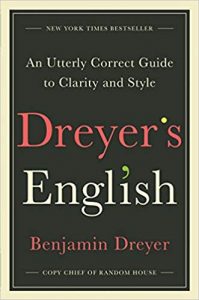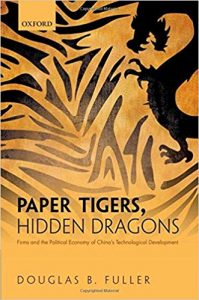 Dreyer’s English: An Utterly Correct Guide to Clarity and Style
Dreyer’s English: An Utterly Correct Guide to Clarity and Style
By Benjamin Dreyer
Evelyn Waugh (is said to have) said good writing requires three elements: clarity, euphony and concision. That’s all good and well, except it either elides or leaves to the discretion of an author what is clear, what sounds good and what drags on too long. Between those pillars of prose lies an interminable gulf filled with interpretations of what qualifies as good by those who think they know what qualifies as right.
The debate over what’s right is as old as writing itself. (For more on this, check out Nicholas Carr’s “The Shallows: What the Internet Is Doing to Our Brains,” a portion of which explains how humans struggled to slowly wrap their minds around the written word.) In time, that debate gave birth to a codification of rules. Just as musicians need a universally accepted arrangement of symbols and scratchings to let each other know what to play and how to play it, so too do readers need a set of guidelines to understand what’s being conveyed. It’s a little arbitrary, sure, but it’s in service to a worthwhile goal: consistency. As an old editing mentor of mine joked, “It’s better to be consistently wrong than intermittently right.”
What confuses the argument between “right” and “wrong” is the fact that every publishing house, government agency and media outlet, including GPF, has its own style guide, each dedicated to a specific audience whose needs and expectations differ from the other. Style guides all share the same broad rules that govern grammar, but they differ widely on the finer points of usage, spelling, transliterations, abbreviations and so on, such that a sentence abiding perfectly by the rules of the Chicago Manual of Style can necessarily run afoul of the AP Stylebook. In that sense, whether or not it’s appropriate to use, say, an Oxford comma is circumstantial, just as the question of whether it’s legal to hold a ball in your hands depends on which sport you’re playing.
These guides, notably, are also written at a specific point in time. Best practices are best practices for a reason, but what’s best tends to be defined by the arbiters of grammatical propriety in a given era. Language naturally changes, and its evolution has created and perhaps even necessitated a marketplace for the improvement of prose where wordsmiths can share their wisdom in the pages of “definitive” tomes that transcend bespoke style guides. The standard-bearer in this niche industry is, of course, “The Elements of Style,” which, despite some fastidious adherence to certain anachronisms, should still be a go-to resource for anyone working with letters. But there are plenty of others in the pantheon – “Eats, Shoots & Leaves: The Zero Tolerance Approach to Punctuation,” “A World Without ‘Whom’: The Essential Guide to Language in the BuzzFeed Age,” and “Dreyer’s English: An Utterly Correct Guide to Clarity and Style” are merely some of the most recent.
“Dreyer’s English” stands out by ably walking the line between prescriptivism and descriptivism – that is to say its author, Benjamin Dreyer, the copy chief of Random House, picks his battles judiciously. To him, certain grammatical rules are inviolable – verbs need to agree with their subjects, dangling participles need to be undangled, sentence fragments are bad. But if the purpose of prose is to illuminate a reader, especially one reading the kind of creative, long-form literature Random House publishes, or to, God forbid, make reading enjoyable for the reader, then certain allowances not only can be made but should be made. Take contractions, for example. Once deemed taboo by middle school teachers of the English-speaking world, contractions are a great way to make even “formal” writing sound less stuffy and stilted. The same could be said of ending a sentence with a preposition or starting a sentence with a conjunction.
These are admittedly minor examples, but they are the kinds of things that, taken together, can give written work a completely different tone or tenor. And this is exactly what distinguishes “Dreyer’s English” from “The Elements of Style.” The latter is meant to be cited. The former is meant to be read. It contains the customary how-tos, common missteps and best practices you’d find in similar works, but it’s chock full of anecdotes and asides born from a career among words. No doubt that has much to do with the personality of its author, but I have to think it also reflects how the marketing of books and the criteria for publishing them, has, like grammar itself, changed over time.
Cole Altom, managing editor
 Paper Tigers, Hidden Dragons: Firms and the Political Economy of China’s Technological Development
Paper Tigers, Hidden Dragons: Firms and the Political Economy of China’s Technological Development
By Douglas B. Fuller
There’s a pattern to U.S. behavior in the face of emerging threats; it’s marked by swings from inattention and half-measures to alarm and, at times, overcorrection as it attempts to overwhelm the problem with blunt power. This is particularly the case with threats involving (a) a weaker but highly motivated adversary developing (b) tools that may or may not be any good but, if good, would give it (c) the potential to offset the United States’ vast conventional military and geographic advantages. Attach significant potential economic and diplomatic risks to most available tools for mitigating the threats, and it becomes really hard to land on a well-calibrated strategy that preserves national security without inflicting excessive damage to the U.S.’ own industry.
That’s the case today with the mounting “geo-tech war” between the U.S. and China. The U.S. has good economic, strategic and military reasons to be concerned about China’s dogged campaign to break into advanced manufacturing and emerging and foundational technologies such as next-generation telecommunications infrastructure, artificial intelligence, space applications, and so forth. China is trying to compete in industries that the U.S. and other advanced economies have dominated for decades, meaning Chinese firms today are still overwhelmingly dependent on foreign technology in most cutting-edge sectors. But China’s bottomless labor pool and consumer market, its ability to provide seemingly limitless funding and diplomatic support to strategic industries, and the success of a few high-profile firms like Huawei have many in the U.S. fretting about a future “decoupled” world marked by discrete Western- and Chinese-centric tech spheres.
But are Chinese firms really good enough to end their dependence on foreign core technologies – which, at present, are a major source of U.S. leverage? Can the Chinese state-centric model for tech innovation – something that historically has flourished only in places with free-wheeling, risk-embracing entrepreneurial cultures and nimble financial systems (i.e. not China) – really succeed? Such questions are central to not only the future of the U.S.-China competition and the broader balance of power but also China’s own desperate scramble to put its economy on more sustainable footing.
Douglas Fuller’s “Paper Tigers, Hidden Dragons” is an insightful look at both the promise and pitfalls of the Chinese model. Fuller divides the Chinese tech sector into three basic types of firms: state-owned enterprises or “state-favored” private sector firms, multinational corporations, and what he calls hybrid firms. The roles of MNCs and Chinese firms with state financial backing get most of the attention in the tech war, but Fuller’s study makes clear that these firms are doing relatively little to accelerate China’s race to the technological frontier. State-backed firms, though capable of distorting global markets enough to impede innovation among established players elsewhere, are beset with the same problems that have always dogged inefficient firms in state-dominated economies. Their easy access to funding and role in supporting state political aims skew incentives and breed bloat and indiscipline – typically making them uncompetitive beyond even what rampant intellectual property theft can overcome. MNCs, though often willing to transfer technology to local partners in exchange for market access, are rarely so myopic that they willingly sow the seeds for their own demise by giving away core technologies. According to Fuller, though, hybrid firms – typically, ethnic Chinese-owned firms fully committed to China but also sourcing investment and talent from places like Taiwan, Hong Kong and Singapore – “are the hidden dragons driving China’s technological development.” Such firms are most likely to have both the market-enforced discipline and outside funding and expertise needed to drive technological development.
Bottom line: With China leaning ever more heavily on the state sector to manage its mounting socio-economic stresses, its successes in the tech sphere are likely to be spotty, at best. But the success of hybrid firms like Huawei shows how Chinese challengers will inevitably emerge. Given the costs of targeting Chinese firms with measures like export bans, the U.S. would be wise to pick its battles.
Phillip Orchard, analyst






